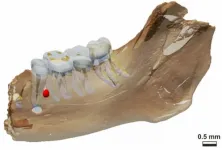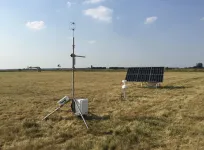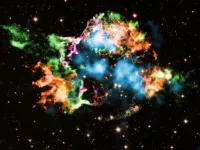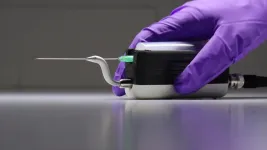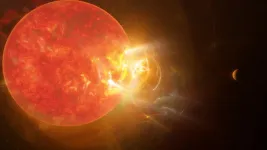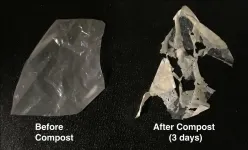Biodegradable plastic bags and containers could help, but if they're not properly sorted, they can contaminate otherwise recyclable #1 and #2 plastics. What's worse, most biodegradable plastics take months to break down, and when they finally do, they form microplastics - tiny bits of plastic that can end up in our oceans, fish, and even our bodies.
Now, as reported in the journal Nature, scientists at the Department of Energy's Lawrence Berkeley National Laboratory (Berkeley Lab) and UC Berkeley have designed an enzyme-activated compostable plastic that could diminish microplastics pollution, and bodes great promise for plastics upcycling - by breaking plastic down to its building blocks, small molecules called monomers - and then recycling those monomers to start a new cycle of compostable plastic.
"In the wild, enzymes are what nature uses to break things down - and even when we die, enzymes cause our bodies to decompose naturally. So for this study, we asked ourselves, 'How can enzymes biodegrade plastic so it's part of nature?" said senior author Ting Xu , who holds titles of faculty senior scientist in Berkeley Lab's Materials Sciences Division, and professor of chemistry and materials science and engineering at UC Berkeley.
At Berkeley Lab, Xu - who for nearly 15 years has dedicated her career to the development of functional polymer materials inspired by nature - is leading an interdisciplinary team of scientists and engineers from universities and national labs around the country to tackle the mounting problem of plastic landfill posed by both single-use and so-called biodegradable plastics.
Most biodegradable plastics in use today are usually made of polylactic acid (PLA), a vegetable-based plastic material blended with cornstarch. There is also polycaprolactone (PCL), a biodegradable polyester that is widely used for biomedical applications such as tissue engineering.
But the problem with conventional biodegradable plastic is that they're indistinguishable from single-use plastics such as plastic film - so a good chunk of these materials ends up in landfills. And even if a biodegradable plastic container gets deposited at an organic waste facility, it can't break down as fast as the lunch salad it once contained, so it ends up contaminating organic waste, said co-author Corinne Scown, a staff scientist and deputy director for the Research, Energy Analysis & Environmental Impacts Division in Berkeley Lab's Energy Technologies Area.
Another problem with biodegradable plastics is that they aren't as strong as regular plastic - that's why you can't carry heavy items in a standard green compost bag. The tradeoff is that biodegradable plastics can break down over time - but still, Xu said, they only break down into microplastics, which are still plastic, just a lot smaller.
So Xu and her team decided to take a different approach - by "nanoconfining" enzymes into plastics.
Putting enzymes to work
Because enzymes are part of living systems, the trick would be carving out a safe place in the plastic for enzymes to lie dormant until they're called to action.
In a series of experiments, Xu and co-authors embedded trace amounts of the commercial enzymes Burkholderia cepacian lipase (BC-lipase) and proteinase K within the PLA and PCL plastic materials. The scientists also added an enzyme protectant called four-monomer random heteropolymer, or RHP, to help disperse the enzymes a few nanometers (billionths of a meter) apart.
In a stunning result, the scientists discovered that ordinary household tap water or standard soil composts converted the enzyme-embedded plastic material into its small-molecule building blocks called monomers, and eliminated microplastics in just a few days or weeks.
They also learned that BC-lipase is something of a finicky "eater." Before a lipase can convert a polymer chain into monomers, it must first catch the end of a polymer chain. By controlling when the lipase finds the chain end, it is possible to ensure the materials don't degrade until being triggered by hot water or compost soil, Xu explained.
The scientists also learned that this strategy only works when BC-lipase is nanodispersed - in this case, just 0.02 percent by weight in the PCL block - rather than randomly tossed in and blended.
"Nanodispersion puts each enzyme molecule to work - nothing goes to waste," Xu said.
And that matters when factoring in costs. Industrial enzymes can cost around $10 per kilogram, but this new approach would only add a few cents to the production cost of a kilogram of resin because the amount of enzymes required is so low - and the material has a shelf life of more than 7 months, Scown added.
The proof is in the compost
X-ray scattering studies performed at Berkeley Lab's Advanced Light Source characterized the nanodispersion of enzymes in the PCL and PLA plastic materials.
Interfacial-tension experiments conducted by co-author Tom Russell revealed in real time how the size and shape of droplets changed as the plastic material decomposed into distinct molecules. The lab results also differentiated between enzyme and RHP molecules.
"The interfacial test gives you information about how the degradation is proceeding," he said. "But the proof is in the composting - Ting and her team successfully recovered plastic monomers from biodegradable plastic simply by using RHPs, water, and compost soil."
Russell is a visiting faculty scientist and professor of polymer science and engineering from the University of Massachusetts who leads the Adaptive Interfacial Assemblies Towards Structuring Liquids program in Berkeley Lab's Materials Sciences Division.
Developing a very affordable and easily compostable plastic film could incentivize produce manufacturers to package fresh fruits and vegetables with compostable plastic instead of single-use plastic wrap - and as a result, save organic waste facilities the extra expense of investing in expensive plastic-depackaging machines when they want to accept food waste for anaerobic digestion or composting, Scown said.
Since their approach could potentially work well with both hard, rigid plastics and soft, flexible plastics, Xu would like to broaden their study to polyolefins, a ubiquitous family of plastics commonly used to manufacture toys and electronic parts.
The team's truly compostable plastic could be on the shelves soon. They recently filed a patent application through UC Berkeley's patent office. And co-author Aaron Hall, who was a Ph.D. student in materials science and engineering at UC Berkeley at the time of the study, founded UC Berkeley startup Intropic Materials to further develop the new technology. He was recently selected to participate in Cyclotron Road, an entrepreneurial fellowship program in partnership with Activate.
"When it comes to solving the plastics problem, it's our environmental responsibility to take up nature on its path. By prescribing a molecular map with enzymes behind the wheel, our study is a good start," Xu said.
INFORMATION:
Co-authors on the paper include Christopher DelRe (lead author), Yufeng Jiang, Philjun Kang, Junpyo Kwon, Ivan Jayapurna, Zhiyuan Ruan, Le Ma, Kyle Zolkin, Tim Li, and Robert Ritchie.
The Advanced Light Source is a DOE Office of Science user facility at Berkeley Lab.
This work was supported by the DOE Office of Science. Additional support was provided by DOE's Laboratory Directed Research and Development program, and the U.S. Department of Defense.
The technology is available for licensing and collaboration. If interested, please contact Berkeley Lab's Intellectual Property Office, ipo@lbl.gov.
Founded in 1931 on the belief that the biggest scientific challenges are best addressed by teams, Lawrence Berkeley National Laboratory and its scientists have been recognized with 14 Nobel Prizes. Today, Berkeley Lab researchers develop sustainable energy and environmental solutions, create useful new materials, advance the frontiers of computing, and probe the mysteries of life, matter, and the universe. Scientists from around the world rely on the Lab's facilities for their own discovery science. Berkeley Lab is a multiprogram national laboratory, managed by the University of California for the U.S. Department of Energy's Office of Science.
DOE's Office of Science is the single largest supporter of basic research in the physical sciences in the United States, and is working to address some of the most pressing challenges of our time. For more information, please visit energy.gov/science.

